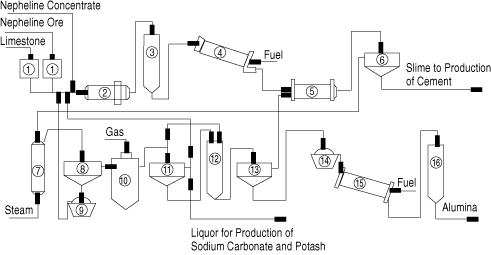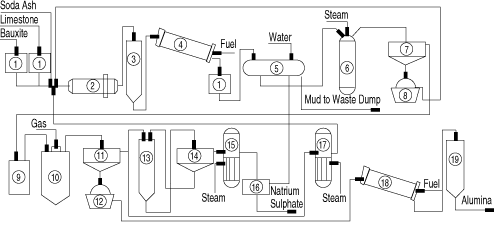 | 48 (8) (1996), pp. 24-26. JOM is a publication of The Minerals, Metals & Materials Society |
|---|
 | 48 (8) (1996), pp. 24-26. JOM is a publication of The Minerals, Metals & Materials Society |
|---|
| CONTENTS |
|---|
After the revolution, the government and research institutions began to address the need to domestically produce aluminum. Key developments included
Complementary to these activities, various departments and laboratories that were focused on nonferrous metals in general and aluminum in particular were reorganized in 1931 into a light metals research institute (NIISaluminiy) and a design institute (Hyproaluminiy). Later, these organizations were combined as the All-Union Aluminium & Magnesium Institute (VAMI), which is today known as VAMI Ltd. The task of the new institutes was to coordinate research and development as well as the overall development of the Soviet aluminum and alumina enterprises.
During the construction of the Volkhov and Dnepr smelters, it was decided to increase the country's total aluminum production capacity to 70,000 t/y. The decision was based, in part, on the 1931-1932 discoveries of additional bauxite deposits in the Ural Mountains. Hence, two new alumina production facilities were planned—a 40,000 t/y plant near the Tikhvin mines and a 60,000 t/y plant in the Urals. The Tikhvin plant used a wet-mix variation of the alumina production technology employed at the Volkhov complex.
In 1933, development of the bauxite mines near Nadejdinsk (currently known as the Northern Ural bauxite mines) was initiated, as was construction of the Ural aluminum complex. This complex was built near Kamensk-Ural because of the nearby bauxite and coal reserves. The project stipulated construction of an accompanying 70,000 t/y alumina facility that would employ the Bayer method to treat the local hydrorhillite bauxite. However, after reassessing the quality of the diaspore Northern Ural bauxite deposits, it was decided to instead employ a novel autoclave method of bauxite digestion. In some stages of the construction, design concepts from Pechiney were employed. In 1939, the first alumina was produced at the Ural complex.
In 1941, there were four alumina plants in the Soviet Union. With the German invasion of Russia, however, this situation changed drastically:
On June 17, 1943, aluminum hydroxide was produced at Bogoslovsk; on April 17, 1944, the calcination furnace was put into operation and the first alumina was produced. Only after the war was the Bayer flowsheet adopted at the plant (utilizing equipment from the sintering shop). By the early 1970s, after numerous expansions, this plant was producing more than 1,000,000 t/y of alumina. Also after the war, the expansion of the alumina production line continued at the Ural aluminum smelter, where a second alumina shop was built in the 1960s for treating high-carbonate material by the thermal caustic treatment of soda. Similar to the Bogoslovsk smelter, the Ural complex's output of alumina exceeded 1,000,000 t/y by the 1970s.
 Figure 1. The flowsheet for alumina production from nepheline ore. 1—crushing; 2—wet grinding; 3—correction of pulp; 4—sintering; 5—leaching; 6—thickening and washng; 7—desilication of liquor; 8—thickening of white mud; 9—filtration of white mud; 10—carbonization of liquor; 11—thickening of seed; 12—precipitation; 13—thickening; 14—filtration; 15—calcination; 16—silo for alumina. |
 Figure 2. The flowsheet of alumina production from high-silicon bauxite by a sintering method. 1—crushing; 2—wet grincing; 3—correction of pulp; 4—sintering; 5—leaching; 6—first desilication; 7—thickening; 8—filtration; 9—second desilicatin; 10—carbonization; 11—thickening; 12—filtration; 13—precipitation; 14—thickening; 15—evaporation; 16—filtration; 17—evaporation; 18—calcination; 19—silo for alumina. |
Also during the late 1950s, construction of an alumina complex near Achinsk in Krasnoyarsk was initiated. Located near the region's largest coal deposits, this plant was designed to be the primary alumina source to the rapidly developing aluminum industry in Eastern Siberia. Like all the alumina production facilities that came before it, the site-specific technology and plant design were developed by VAMI. In 1963, a pilot plant was opened to best identify specific operating parameters for the site. In 1970, large-scale alumina and soda production began; capacity was for 900,000 t/y of alumina and 464,000 t/y of carbonates. Taking into account processing lines that were put into operation during 1978-1980, the cement capacity at Achinsk is 4,400,00 t/y. The nepheline ore used at the plant comes from the Kiya-Shaltir deposit, which is 265 km from Achinsk. The limestone comes from the Mazul limestone deposit, which is actually part of the Achinsk alumina complex.
As of January 1, 1995, Russia was operating six alumina production lines (Table I); in 1994, they combined to produce nearly two million tonnes of alumina. Of this figure, 67% was produced from the bauxite (including high-silica-content bauxite); the rest was produced from nepheline materials (Table II). The technologies at these plants will be discussed in the second part of this article.
| Table I. Russia's Alumina Production Facilities | |||
|---|---|---|---|
| Plant | Year Opened | 1994 Alumina Production | Products |
| Alumina Complexes | |||
| 1970 | 436,000 | Alumina and hydroxide, cement, soda, potash, potassium sulfate |
| 1953 | 152,000 | Alumina and hydroxides, corundum |
| 1959 | 192,000 | Alumina and hydroxides, cement, soda, potash |
| Alumina Lines at Smelters | |||
| 1943 | 791,000 | Alumina and hydroxide |
| 1952 | 23,000 | Alumina and hydroxides, cement, soda, potash |
| 1939 | 374,000 | Alumina ahnd hydroxides |
| Table II. Raw Materials Used for Russian Alumina Production | |||||||||||
|---|---|---|---|---|---|---|---|---|---|---|---|
| Composition | |||||||||||
| Plant | Source | Raw Material | Al2O3 | SiO2 | Fe2O3 | CaO | Na2O | K2O | S | Moisture | |
| Alumina Complexes | |||||||||||
| Kiya-Shaltir Deposit | Nepheline Ore | 26.5 | 39.6-40.5 | 4.6-5 | 7.9 | 11.8 | 2.7 | — | 2 | |
| Tikhvin Mine | Boehmite Bauxite | 43-45 | 15-16 | 14-15 | 1.4 | — | — | 0.2 | 15 | |
| Complex Apatite | Nepheline Conc. | 28-28.6 | 44 | 3.5 | 1.4-1.5 | 12.8 | 7.6 | — | 0.12 | |
| Alumina Lines at Smelters | |||||||||||
| North-Ural Mines | Diaspore Bauxite | 53-54 | 3.7 | 22-23 | 3.7-3.9 | — | — | 0.9-1.0 | 8-9 | |
| Southern Ural Mines | Bohemite Bauxite | 46-47 | 8.4-9.3 | 19.1-19.6 | 5-9 | — | — | 0.8-1.1 | 2-3 | ||
| Complex Apatite | Nepheline conc. | 28-28.6 | 44 | 3.5 | 1.4-1.5 | 12.8 | 7.6 | — | 0.12 | |
| Northern Ural Mines | Diaspore Bauxite | 53-54 | 3.7 | 22-23 | 3.7-3.9 | — | — | 0.9-1.0 | 8-9 | |
| Southern Ural Mines | Boehmite Bauxite | 44-47 | 8.4-9.3 | 19.1-19.6 | 5-9 | — | — | 0.8-1.1 | 2-3 | ||
Russia's alumina plants were built, expanded, and modernized under the market conditions that were provided by a "closed" economy; as a result, power and fuel prices were significantly lower as compared to those found in the world market. Hence, in Russia's transition to a market economy, the first priority of alumina producers is to optimize power efficiency at the plants.
For the production facilities that treat bauxite, the plan is to reduce total heat consumption by increasing the digestion temperature and better contain the heat within the processing circuit. A drastic drop in steam consumption will be achieved through rearrangement of equipment and improved process control that should allow reduced water intake, greater heat recuperation from the autoclave batteries, and reduced alkali recycling due to the use of a higher purity liquor (achieved by improving the operation of the hydrate slurry filtration units after precipitation). Further, the use of easier-to-recover boehmite bauxites from the Middle Tyman deposits presents additional opportunities to save heat at the Ural Plants.
The critical step in reducing heat consumption at plants using nepheline raw materials is conversion to the semi-wet sintering of nepheline-limestone charges in conjunction with the use of Bellite mud with limestone for cement production. This concept provides for preliminary filtration of the initial slurry with a reduction in water content from 30% to 15%; filtration is followed by countercurrent processing in a cyclone system, which reduces fuel consumption 20-25% and increases kiln efficiency. The latter factor is of particular interest for the Achinsk Alumina Combinate.
Another trend for improving alumina production economics involves expanding the plants' product mix. For the plants using nepheline raw materials, this could include the production of construction materials, fillers, insert setting mixtures, adsorbents, semi-products (e.g., hydrogarnet muds, carboaluminate, and other compounds), and new high-quality products (e.g., casting cements and high-alumina cements). Also, the technology for converting the potash to potassium sulfate is being developed.
Additional opportunities exist for the fabrication of special products (e.g., fine-dispersed, ultrahigh-purity, ultralow-alkali active grades of oxide and specialty grades of aluminum hydroxide). At present, specialty-grade alumina is only being used for white electrocorundum, pots, refractories, specialty ceramics, catalytic agents, and microelectronics.
Based on these opportunities, in tandem with the continued strength of having the alumina producers being so closely positioned in relation to their raw materials and their smelter customers, the future of Russian alumina production appears bright. With ongoing world growth in aluminum consumption, it is anticipated that Russian final alumina production numbers from 1995 should be 2.20-2.23 million tonnes—a significant increase over 1994's alumina production of 1.99 million tonnes.
Lomako, Pietr F. Non Ferrous Metallurgy during the Great Patriotic War. Moscow: Metallurgy (1985).
Prokopov, Igor V., Vadim S. Smirnov, and Nikolay N. Tikhonov. "Main Trends in the Field of Improvement of Russian Alumina Industry." Non Ferrous Metals. Vol. 9 (1991): pp. 13-15.
Prokopov, I.V. "Aluminum Industry of Russia, Present State and Development." Paper presented at the international conference Russian Aluminum Industry—Strategy of Development and New Investment Projects, 15-18 September, 1992.
Siziakov, V.M., et al., "Some Trends of Alumina Industry Development in Russia." Non Ferrous Metals. Vol. 2 (1995): pp. 37-40.
Smirnov, V.S., and A.E. Montvid. "Techno-Economical Estimation of Heat Diagrams of Bayer Process." Paper presented during a scientific technical session at VAMI, Leningrad, 14-17 September, 1971. P>Smirnov, V.S., and N.N. Tikhonov. "Main Trends of Alumina Industry Development in USSR." Paper presented at the international conference Scientific and Technical Progress in Non Ferrous Metallurgy, St. Petersburg, 17 September, 1991.
Smirnov, V.S. "Raw Materials of Russian Aluminum Industry—New Investment Projects." Paper presented at the international conference Russian Aluminum Industry—Strategy of Development and New Investment Projects, St. Petersburg, 15-18 September, 1992.
For more information, contact V. Smirnov, VAMI Ltd., 199026, Szedniy Prospect, 86, St. Petersburg, Russia; (812) 2-175-225; fax (812) 2-175-986.
Direct questions about this or any other JOM page to jom@tms.org.
| Search | TMS Document Center | Subscriptions | Other Hypertext Articles | JOM | TMS OnLine |
|---|